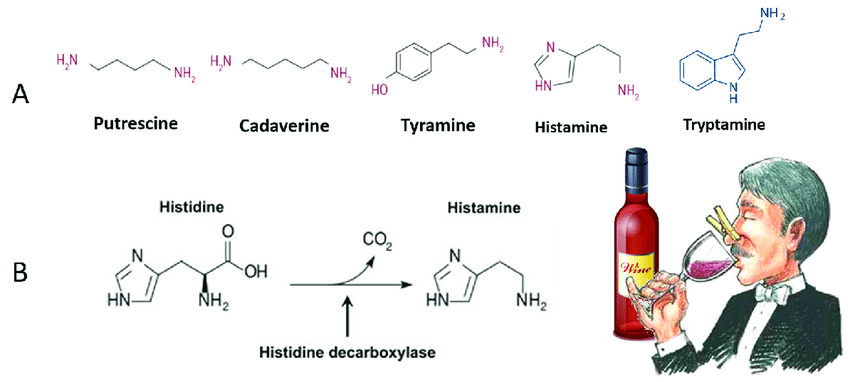
Biogenic amines (BAs) are nitrogenous compounds that can be found in various foods and beverages, including wine. They are primarily formed through the decarboxylation of amino acids by microorganisms. In wine, biogenic amines can be produced at different stages of the production process, from the vineyard to the fermentation stages. The main biogenic amines found in wine are histamine, tyramine, putrescine, and cadaverine.
It’s important to control the levels of biogenic amines in wine because high concentrations can pose health risks to humans, such as headaches, hypertension, and allergic reactions. Winemakers can manage biogenic amine levels through careful selection of yeast and bacteria strains, as well as by maintaining good hygiene and sanitation practices during the winemaking process
The presence of biogenic amines in wine is influenced by several factors:
- Variety of grapes: Different grape varieties may contain varying levels of biogenic amines.
- Fermentation process: Both alcoholic fermentation (AF) and malolactic fermentation (MLF) can contribute to the formation of biogenic amines. Yeasts involved in AF and bacteria involved in MLF can produce biogenic amines
- Microbial activity: The activity of certain spoilage organisms and lactic acid bacteria can lead to higher levels of biogenic amines in win
- Soil type and composition: These can affect the levels of biogenic amines in the grapes themselves.
The relationship between biogenic amines and pH in soil is quite complex and can vary depending on several factors. Generally, the pH level can influence the microbial activity in the soil, which in turn can affect the formation of biogenic amines. For instance, certain microorganisms that produce biogenic amines thrive in more acidic conditions, while others may be active in neutral or slightly alkaline pH levels.
Research has shown that there is a correlation between the pH value and the content of biogenic amines in silage, which is an important consideration in agricultural practices. Lower pH values in silage, which indicate more acidic conditions, have been associated with higher biogenic amine content. This is because acidic conditions can favor the growth of lactic acid bacteria, some of which are capable of decarboxylating amino acids to form biogenic amines.
Moreover, the Spearman correlation coefficient has been used to analyze the relationship between biogenic amine content and pH, indicating that there is a statistical relationship between these variables. It’s important to note that while these studies provide insights into the relationship between pH and biogenic amines in silage, similar principles can apply to soil, given that pH affects microbial communities and their metabolic activities.
If you want to discover more about the role of sulfites and BAs in wine, join NWT Sulphites: Mystery Solved wine-tasting.
